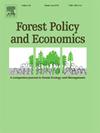Calling into the void? German forest dieback 2.0 debate on Twitter. A case study to operationalize the analysis of discursive power in hybrid media systems
IF 3.8
2区 农林科学
Q1 ECONOMICS
引用次数: 0
Abstract
Forest dieback 2.0 is the common term for describing climate change-related forest damages that sparked a nation-wide debate in Germany starting in 2018. Referring to the “first” forest dieback in the 1980s that inspired environmental movements and policy changes, raises questions concerning today's mobilization potential. Political communication has been profoundly transformed, mainly through the spread of digital media. To understand the current debate, it is thus crucial to consider the complex entanglements in hybrid media systems. We contribute to the operationalization of analyzing discursive power in hybrid media systems, through Twitter-actor-networks as well as tweet-hyperlink-networks, representing a communication space where older and newer media logics blend. Results suggest a scattered debate characterized by insulated communication networks of few central actors. Whereas forestry frames dominate original tweets, nature conservation frames are more likely to be amplified through retweets. Despite having largest number of followers, legacy media actors show low centralities in the Twitter-network. However, their influence must be seen in regard to the referred hyperlinks. Interactions between tweets and hyperlinks revealed different mechanisms for how frames are introduced and amplified. Besides mainly following the cleavage between forestry and nature conservationists, alternative frames instrumentalize forest damages to call for climate action or climate change skepticism. Despite these controversies and insulated communication, the forest dieback 2.0 debate on Twitter does not appear to be destructively polarized. Nevertheless, further research needs to carefully examine the polarization potential. Due to the limited outreach, however, the Twitter debate largely seems like a calling into the void.
向虚空呼唤?推特上关于德国森林枯死病2.0的讨论。运用混合媒体系统中话语权力分析的个案研究
森林枯死2.0是描述与气候变化相关的森林破坏的常用术语,从2018年开始在德国引发了一场全国性的辩论。提到1980年代引发环境运动和政策变化的“第一次”森林枯死,提出了有关今天动员潜力的问题。政治传播已经发生了深刻的变化,主要是通过数字媒体的传播。因此,为了理解当前的争论,考虑混合介质系统中的复杂纠缠是至关重要的。我们通过推特-行动者网络以及推特-超链接网络,为分析混合媒体系统中的话语力量的操作化做出贡献,代表了新旧媒体逻辑融合的通信空间。结果表明,一场分散的辩论以少数核心参与者的隔离通信网络为特征。虽然林业框架主导了原始推文,但自然保护框架更有可能通过转发被放大。尽管拥有最多的追随者,但传统媒体演员在twitter网络中的中心性较低。但是,必须看到它们对所引用的超链接的影响。tweet和超链接之间的交互揭示了框架如何被引入和放大的不同机制。除了主要遵循林业和自然保护主义者之间的分裂之外,其他框架将森林损害作为工具,呼吁采取气候行动或气候变化怀疑主义。尽管存在这些争议和孤立的交流,但Twitter上关于森林枯死2.0的辩论似乎并没有出现破坏性的两极分化。然而,进一步的研究需要仔细研究极化电位。然而,由于推广范围有限,推特上的辩论在很大程度上似乎是在呼唤空虚。
本文章由计算机程序翻译,如有差异,请以英文原文为准。
求助全文
约1分钟内获得全文
求助全文
来源期刊

Forest Policy and Economics
农林科学-林学
CiteScore
9.00
自引率
7.50%
发文量
148
审稿时长
21.9 weeks
期刊介绍:
Forest Policy and Economics is a leading scientific journal that publishes peer-reviewed policy and economics research relating to forests, forested landscapes, forest-related industries, and other forest-relevant land uses. It also welcomes contributions from other social sciences and humanities perspectives that make clear theoretical, conceptual and methodological contributions to the existing state-of-the-art literature on forests and related land use systems. These disciplines include, but are not limited to, sociology, anthropology, human geography, history, jurisprudence, planning, development studies, and psychology research on forests. Forest Policy and Economics is global in scope and publishes multiple article types of high scientific standard. Acceptance for publication is subject to a double-blind peer-review process.
 求助内容:
求助内容: 应助结果提醒方式:
应助结果提醒方式:


